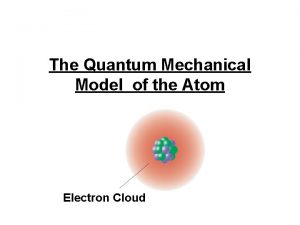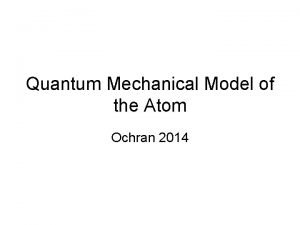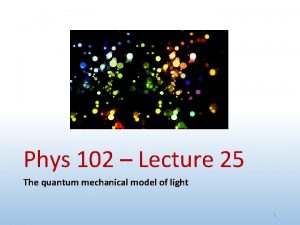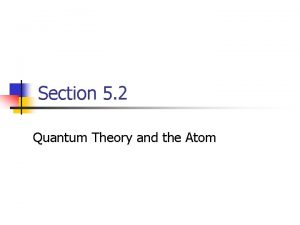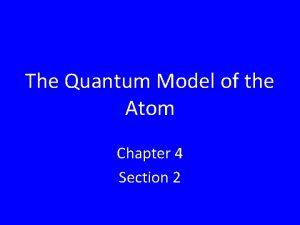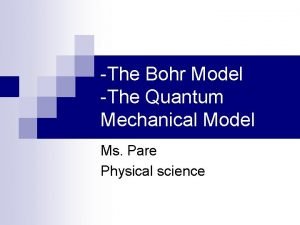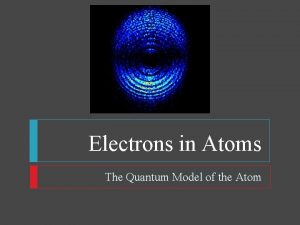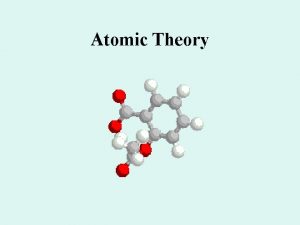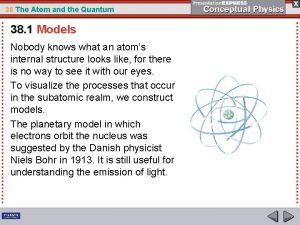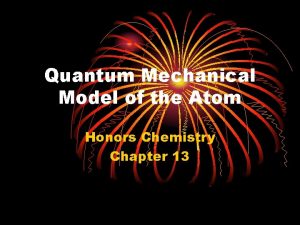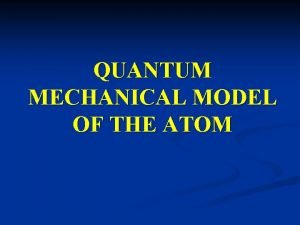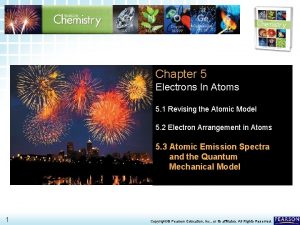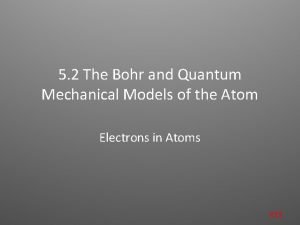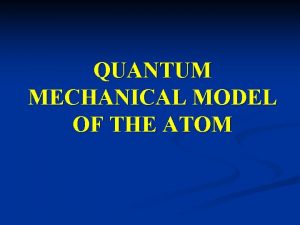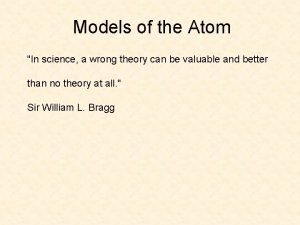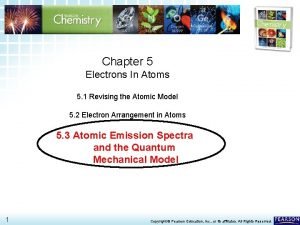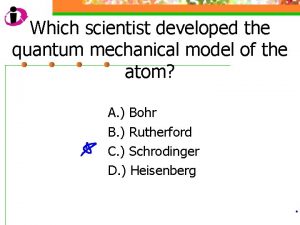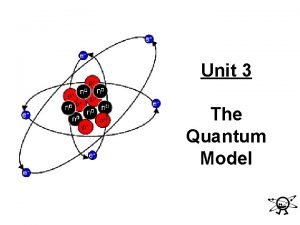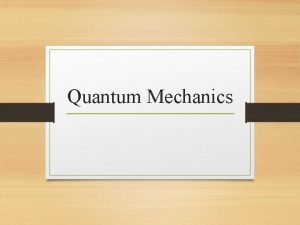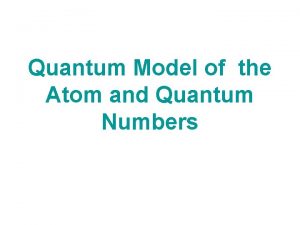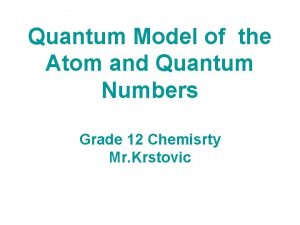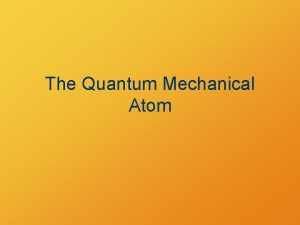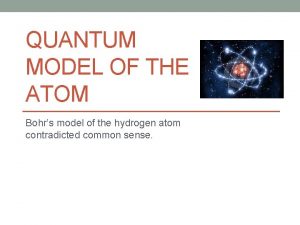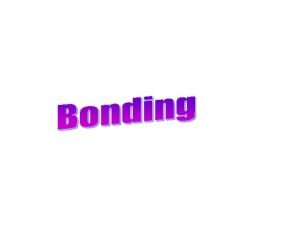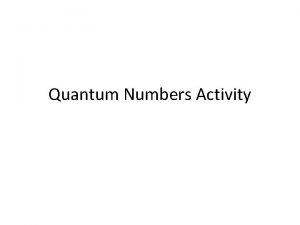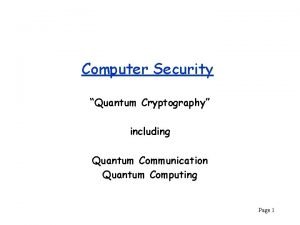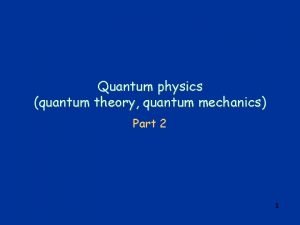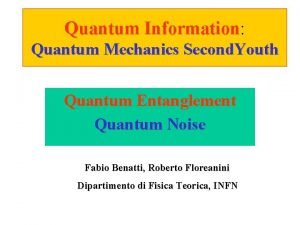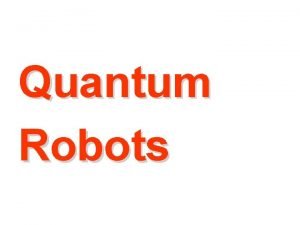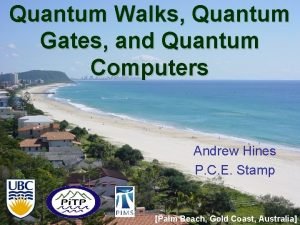Quantum Model of the Atom The Atom is
























- Slides: 24

Quantum Model of the Atom

The Atom is like a Hotel, not a solar system Copy the diagram on the board if you have not done so.

Electrons do not circle a nucleus willy-nilly. They have assigned positions that only extra energy can cause them to jump into another position ( ex: photoelectric effect )

Unfortunately, we can not identify their EXACT position only the probable area we might find them. These are called orbitals.

Heisenberg Uncertainty Principle We can not know both the position and the momentum of a particle (electron )

Quantum Numbers These are “codes” for describing the area or “room” in which a certain electron might be located

Principal Quantum number “n” Describes the size and energy of the orbital , aka “hotel floor” Can be found on the periodic table is equal to 1 -∞

Practice: Looking at a periodic table… What is the principal quantum number for Titanium?

Practice: Looking at a periodic table… What is the principal quantum number for Titanium? n = 4

Angular momentum quantum number “ℓ “ Describes the shape of the space the electron is in. i. e. what kind of hotel room it is in. is equal to n -1 …… 0

Angular momentum quantum number “ℓ “ Describes the shape of the space the electron is in. i. e. what kind of hotel room it is in. is equal to n -1 …… 0 l = 3, 2, 1, 0

Let’s look at Titanium: n = 4 ℓ = 3 , 2, 1, 0 Each number is code for a different type of room the electron may be in.

continued 3 = “f” orbital, a shape that I can’t describe, ( suite ) On the next slide I will show you pictures of these orbitals.





“ So Titanium is a 4 story hotel with electrons in all four types of orbitals Now let’s see why there are 3 ps, 5 ds and 7 fs ”

Magnetic Quantum number, mℓ Describes the position of the orbital in 3 -d space. It’s spatial orientation. i. e. in the center, by vending machines, at the end of the hall, etc

= +_ ℓ so titanium has +_3, +_2, +_ 1, 0 How many numbers is this? Take the largest orbital ( s, p, d or f) and that’s how many of them you have.

7 numbers , right? Let’s look at those f orbitals again…

Spin Quantum Number, ms Describes the spin of the electron, clockwise or counter = +1/2 or -1/2 ALWAYS

Practice writing the quantum numbers for: 1. Pd 2. U

Practice writing the quantum numbers for: 1. Pd n = 5, l = 4 3 2 1 0 ml = +- (4, 3, 2, 1), 0 Ms = +- ½ 2. U ?
 Kelemahan model atom thomson
Kelemahan model atom thomson Quantum mechanical model of atom
Quantum mechanical model of atom Schrodinger wave mechanical model
Schrodinger wave mechanical model Quantum atom model
Quantum atom model Quantum mechanical model labeled
Quantum mechanical model labeled The p sublevel resembles the ______ shape.
The p sublevel resembles the ______ shape. Quantum physics vs quantum mechanics
Quantum physics vs quantum mechanics Quantum physics vs mechanics
Quantum physics vs mechanics Bohr model vs quantum model
Bohr model vs quantum model Compare and contrast bohr model to quantum model
Compare and contrast bohr model to quantum model Atomic theory graphic organizer
Atomic theory graphic organizer Chapter 38 the atom and the quantum
Chapter 38 the atom and the quantum Lowest allowable energy state of an atom
Lowest allowable energy state of an atom Electrons in atoms section 2 quantum theory and the atom
Electrons in atoms section 2 quantum theory and the atom The structure of the atom section 2 defining the atom
The structure of the atom section 2 defining the atom Quantum mechanical model definition chemistry
Quantum mechanical model definition chemistry What is the electron configuration of 24cr4+?
What is the electron configuration of 24cr4+? Modern quantum mechanical model
Modern quantum mechanical model Atomic emission spectra and the quantum mechanical model
Atomic emission spectra and the quantum mechanical model Quantum mechanical model
Quantum mechanical model What is the electron configuration of 24cr4+?
What is the electron configuration of 24cr4+? Erwin schrödinger atomic theory
Erwin schrödinger atomic theory Atomic emmision spectrum
Atomic emmision spectrum Which scientist developed the quantum mechanical
Which scientist developed the quantum mechanical Schrodenger
Schrodenger

